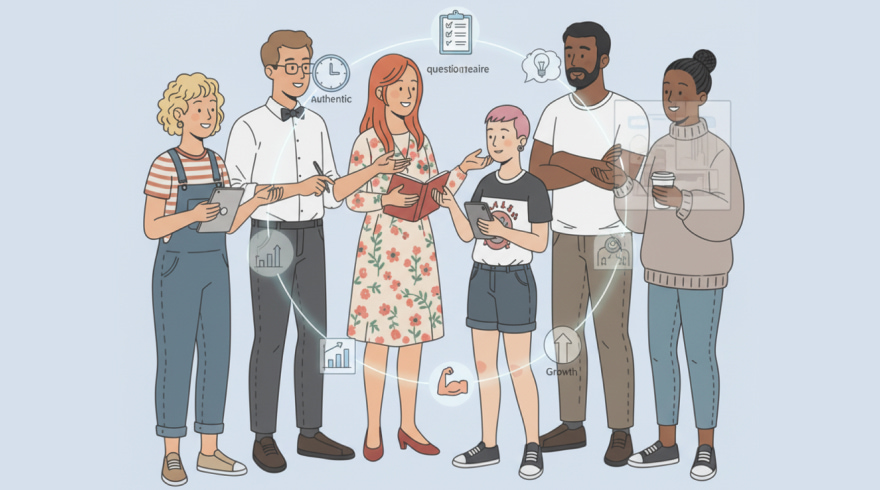Definitive Guide to Employee Leadership Questionnaires That Improve Manager Effectiveness
- 4 November 2025

Why Measuring Leadership Behaviors Elevates Team Performance
Organizations rise or stall based on the everyday behaviors of the people who guide work, resolve friction, and set direction. When those behaviors are visible, measurable, and developed with intention, teams experience clearer priorities, stronger trust, and faster execution. A structured assessment turns vague impressions into evidence, helping companies separate one-off anecdotes from patterns that deserve attention. This clarity reduces bias, anchors conversations in shared facts, and accelerates coaching that actually sticks. Leaders benefit too, because they receive actionable input on how their style lands across diverse personalities and contexts.
Data-informed leadership development has another advantage: momentum. Instead of episodic workshops that fade, frequent measurement creates a rhythm of learning and refinement. Managers see the effects of small habit changes in subsequent cycles, and senior stakeholders can trace improvements back to the specific behaviors that shifted. Over time, this creates a culture where feedback is normalized, micro-skills are celebrated, and the organization learns as one system. The result is a pragmatic playbook for growth that keeps people engaged and strategy moving in sync with reality.
- Clarifies expectations for managers and team leads.
- Reveals strengths worth amplifying and risks needing mitigation.
- Aligns development resources to the highest-impact capabilities.
- Builds credibility by pairing coaching with verifiable progress.
What a Robust Leadership Instrument Should Include
A practical instrument blends science and usability. At the core are well-defined competencies, each translated into plain-language prompts that capture a single behavior at a time. Items should map to observable actions, such as how a manager clarifies goals, handles conflict, or provides recognition. Brevity matters, yet coverage should be broad enough to touch the leadership moments that employees experience weekly. A balanced design will mix relational dynamics, operational rigor, and forward-looking strategy, underpinning a holistic view rather than a narrow snapshot.
Within fast-scaling environments, a standardized leadership questionnaire for employees becomes a shared reference that connects feedback to development plans. Consistent rating scales (for example, five-point Likert) reduce noise, while open-text prompts surface nuance that scores may miss. Weighting can be introduced when certain competencies drive critical outcomes, but transparency about scoring rules is essential. Finally, accessibility considerations, clear language, mobile-friendly layouts, and inclusive phrasing, ensure broad participation and richer datasets across roles and locations.
- Competency definitions that are specific, current, and job-relevant.
- Behaviorally anchored items with one concept per prompt.
- Reliable scales alongside optional comment fields for context.
- Clear instructions, confidentiality assurances, and realistic completion time.
Key Dimensions, Sample Items, and Rating Scales
While every company’s leadership DNA is unique, several dimensions appear in most high-impact assessments. These include vision and direction, communication and transparency, coaching and growth, psychological safety, decision speed, accountability, inclusion, and cross-functional collaboration. Each domain should be represented by multiple items so that a single awkwardly worded prompt does not distort results. Using consistent scales enables comparison across teams, time periods, and segments such as tenure or location, creating the foundation for meaningful trend analysis.
| Dimension | Sample Prompt | Why It Matters | Typical Scale |
|---|---|---|---|
| Vision & Direction | My manager connects our day-to-day tasks to a clear strategy. | Links effort to purpose, reducing churn and confusion. | Strongly Disagree to Strongly Agree (1–5) |
| Communication | My manager shares timely information that affects our work. | Prevents rework and builds trust through transparency. | Never to Always (1–5) |
| Coaching & Growth | My manager provides feedback that helps me improve. | Strengthens capability and accelerates career progress. | Strongly Disagree to Strongly Agree (1–5) |
| Psychological Safety | I can raise concerns with my manager without fear of blame. | Enables learning, innovation, and early risk detection. | Strongly Disagree to Strongly Agree (1–5) |
Use this structure as a template, then localize the wording to reflect your organization’s language and leadership principles. Keep scales consistent to preserve comparability across items. Mix in one or two open questions to capture examples and suggestions; these comments often illuminate the specific behaviors that will move scores in the next cycle. Finally, pilot the instrument with a small group to check clarity, timing, and reliability before rolling it out broadly.
Designing, Running, and Analyzing Your Leadership Assessment
Operational excellence turns a great instrument into a great program. Establish a cadence, quarterly, biannual, or tied to performance cycles, so managers and teams know what to expect. Communicate the purpose, reiterate confidentiality, and provide a realistic window for completion. Remove barriers by making the survey mobile-accessible and concise, and by offering translations where needed. After the window closes, ensure your analytics isolate signals from noise by segmenting responses responsibly and guarding against identifiability in small groups.
- Pre-launch: socialize goals, timelines, and how insights will be used.
- Launch: send clear invitations, reminders, and completion estimates.
- Analysis: examine distributions, medians, and deltas by team and time.
- Follow-up: share findings, agree on two or three focus behaviors, and track progress.
For response quality and adoption, many HR teams streamline distribution with a concise leadership survey questionnaire for employees that integrates with calendar reminders and single sign-on. Pair quantitative patterns with text analytics to surface themes, then validate with brief listening sessions. Prioritize changes using an impact-feasibility matrix, and convert insights into experiments: small, observable habits that can be tried immediately. Close the loop by reporting back on actions taken, which builds trust and improves participation in the next wave.
Turning Insights Into Action and Sustainable Culture Change
Insights only matter when they alter behavior. Translate findings into a handful of clear commitments, then codify them in team rituals such as weekly check-ins, sprint reviews, and one-on-ones. Managers can choose one interpersonal behavior and one operational behavior to practice over a 30–60 day window. Publicly tracking these commitments normalizes learning, while peer coaching groups provide accountability and ideas when momentum dips. Senior leaders should model the same cycle, demonstrating that development is a shared expectation, not remedial work.
- Set two focus behaviors per leader, with simple success metrics.
- Introduce micro-habits that fit naturally into existing meetings.
- Review progress monthly and celebrate visible wins.
- Refresh goals after each measurement cycle to sustain compounding gains.
Over time, this approach turns leadership development into an organizational capability rather than a classroom event. As data accumulates, you can track which behaviors correlate with retention, engagement, and delivery speed, then refine learning pathways accordingly. The compounding effect is powerful: tighter alignment, steadier morale, and fewer execution gaps, all driven by specific, teachable behaviors reinforced through transparent feedback loops.
FAQ: Common Questions About Leadership Questionnaires
How long should an assessment take to complete?
Most high-participation instruments take 7–12 minutes end to end. Brevity sustains response quality, while a mix of 15–25 behaviorally anchored items and one or two open questions captures sufficient detail without fatigue.
What makes the results trustworthy?
Trustworthiness stems from clear constructs, unambiguous wording, consistent scales, and sound statistics. Piloting helps refine items, and reliability checks such as internal consistency testing ensure the instrument measures the intended behaviors.
How often should we run the questionnaire?
Twice a year works for many organizations, with pulse checks in between for targeted topics. The right cadence balances learning speed with change capacity so managers have time to practice and teams can observe real shifts.
Should we include open-text questions?
Yes, brief comment prompts provide crucial context behind scores. Text analytics can reveal patterns, while a quick manual review surfaces vivid examples and practical suggestions leaders can act on immediately.
How do we protect confidentiality?
Aggregate results at a group size threshold (for example, five or more respondents), suppress small segments, and communicate these safeguards up front. Clear protocols build confidence and support candid, actionable feedback.



